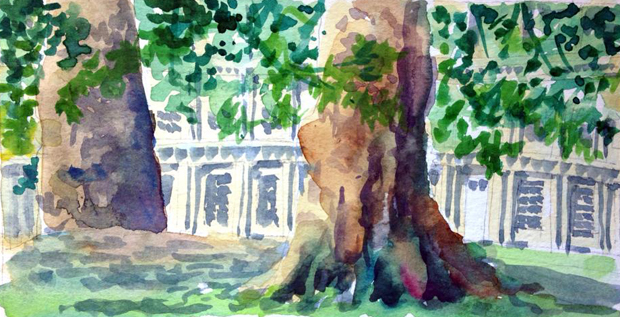This wonderful five-minute talk by Llewellyn Vaughn-Lee about women and the mystery of creation appeals to the great potential of the sacred feminine to help shift our cultural stories. When you think about it, how miraculous it is that women have this ability to bring a new person into the world, to give a soul the experience of this physical plane. Spirit and matter are literally united within a woman’s body.
Throughout most of human history, women, therefore, were the guardians of the spiritual life of the people. Their connection to the earth’s cycles and seasons, as well as its great Creative power, made this connection natural and enduring. Anything we can do to align with the cyclical and the non-linear, the intuitive and the more-than-rational, will feed into this connection.
I recently mentioned the book, The Heroine’s Journey, and its influence on my own creative work. One of the steps on the journey is the urge to reconnect with the feminine, something we’ve been doing in our Restorying retreats: going out into the forest, and connecting at a deep level with the earth in any way that calls our senses. It might be the sound of a stream running over stones or the smell of a dead opossum, the rivulets of rain coursing down the craggy bark of a poplar tree or the garish green of fungus growing on a rotting log.
Restorying is an experimental way of having forest encounters, these experiences of an other-than-rational way of being, a felt sense of presence and of belonging and connection. To wander in the woods under the assumption that everything is alive, that all of Life is conscious and aware, is quite a radical act. It means actively disobeying the rules I’ve been raised to live by. And it feels wonderful.
I attended a course last summer at Schumacher College, taught by the founders of the Dark Mountain Project, Paul Kingsnorth and Dougald Hine. We had many conversations about embracing wildness, which is another way of picturing this shift to new stories that leaves out gender references. Given that their Manifesto calls for “un-civilization,” it makes sense that wildness would be an antidote, or a way station, or something simply to experiment with to see what happens.
I’ve come to believe that this shift is about more than femininity or wildness, or any other contrarian way of being, in and of itself. I feel as though I’m being called to embrace and embody the paradox of opposites. To see myself, my own body, as a threshold upon which opposites can co-exist, all opposites, including known and unknown, inner and outer, flesh and spirit, masculine and feminine, civilized and wild.
It seems likely that the steps we take, and therefore the changes, will be incremental. First, spend some time leaning way over to the feminine and the wild and non-rational, to court a rebalance of the centuries of patriarchy that destroyed the sacred contract of women with an earthly spirituality and impoverished men and women, as well as the earth. Experiencing communion and connection with the natural world, even on the occasional weekend, has a profound effect. I use my writing and other arts (painting and music) to keep the creative channels open, and there are plenty of other ways.
I his book, Anam Cara, John O’Donohue reminds us that separation is the bargain our soul has struck to be incarnated in a body at all. Our soul has left the eternal “everywhen” to walk as a human in place and time, which are both contingent and separate. This is a good reminder, lest we become too caught up in the healing-the-separation aspect of New Story and forget that separation is a fundamental condition to being embodied, and human.
My Restorying partner, Jim, agrees that we would wisely guard against making what we teach an absolute, or the better of some either/or choice. In a culture caught up in the old stories of linearity, separation and control, immersing in aspects of New Story also runs the risk of this either/or thinking. We are decidedly not saying that old is always bad, new is always good. Rather, we are cultivating our ability to dwell in the in-between, to hold the dynamic balance of opposites within us, including elements of the old dominant stories and the new alternative stories, many of which have deep roots in the ancient past.
As Jim says, given where we’re starting from, we have work to do. Surely it is the Great Work of our time, as Thomas Berry put it. In a way, seen in an evolutionary context, we humans are right where we’re supposed to be: finding ways to live with questions and uncertainties, cultivating our sense of wonder and gratitude for this miraculous world.


Hi Julie,
My 2 cents 🙂 Incremental implies measured steps. In my view and experience, change comes in eruptions after a period of gestation. Then another gestation period, which may be longer or shorter than the last, followed by another eruption. I have seen the proverbial light bulb going off in my head on several occasions leading to profound changes in my life.
Keep on Growing,
Duane
Excellent point, Duane. In a way, the very idea of incremental change implies an attempt to control both the pace and the outcome. It’s only when we let loose of those restrictions that real change happens, sometimes easily, sometimes cataclysmically. Definitely something to sit with. Thank you! . . . . It occurs to me that if I could take only one thing with me on this journey, it would be courage.
Pingback: What’s love got to do with it: whispering into the gale of “transhumanism” | Thriving on the Threshold